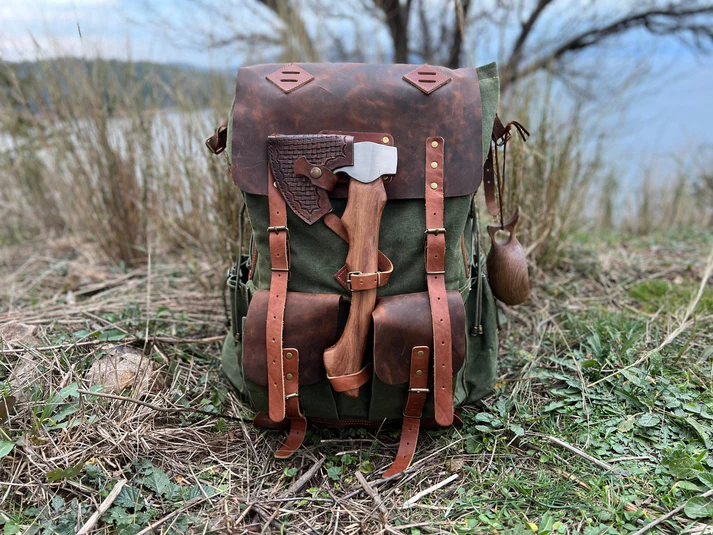When it comes to outdoor adventures, not all backpacks are created equal. Each type of pack is designed with specific activities in mind, whether it’s hiking, camping, mountaineering, or everyday travel. Among these, the bushcraft backpack stands out as a unique choice. Built for survival, durability, and practical use in the wilderness, this style of pack differs significantly from the standard hiking or travel backpack. Understanding these differences is essential for anyone who wants to venture deep into the wild with the right gear.
The Purpose Behind a Bushcraft Backpack
A Buschcraft backpack is not just about carrying supplies—it’s about being prepared for self-sufficiency in nature. Unlike regular backpacks, which are often designed for comfort on well-marked trails or urban use, bushcraft backpacks are tailored for rugged environments where durability and utility matter more than lightweight construction. They are meant to hold tools, shelter gear, and essentials for building, cooking, and surviving in the wilderness.
Material Strength and Durability
One of the first differences you’ll notice is the choice of materials. Bushcraft backpacks are usually crafted from heavy-duty fabrics such as canvas, waxed canvas, or reinforced leather. These materials may feel heavier compared to modern nylon hiking packs, but they are chosen for their toughness and resistance to abrasion. In a dense forest or rocky terrain, a durable backpack prevents tears and withstands years of use without breaking down.
By contrast, most modern hiking or travel backpacks prioritize lightweight synthetic materials like ripstop nylon, which are excellent for reducing overall pack weight but may not offer the same level of ruggedness as canvas or leather.
Capacity and Structure
Bushcraft backpacks often have a simple, boxy structure compared to the streamlined designs of hiking packs. This structure allows for easier packing of bulky items like firewood, tarps, or axes. Their capacity is usually versatile enough for extended outdoor trips where carrying shelter and tools is a must.
Hiking backpacks, on the other hand, are typically designed with internal frames, molded back panels, and ventilation systems to maximize comfort during long treks. They focus more on ergonomic support rather than multipurpose utility.
Pocket and Attachment Design
Organization is another area where bushcraft backpacks differ. Instead of numerous small compartments, they often feature large main sections with a few external pockets. This design keeps things simple and allows the user to carry irregular-shaped tools or gear without restriction.
Many bushcraft packs also come with external attachment points such as leather straps or loops. These are ideal for securing axes, saws, or knives—tools that are central to bushcraft activities. Hiking or travel backpacks, in contrast, tend to emphasize hydration sleeves, small electronics pockets, or trekking pole holders, which serve different purposes.
Weather Resistance
Bushcraft backpacks are often treated with wax or oil coatings that make them water-resistant. This is critical in wilderness environments where you might face rain, snow, or damp conditions. Waxed canvas, in particular, not only repels water but also becomes more characterful and durable over time.
Meanwhile, hiking backpacks often rely on built-in rain covers or synthetic waterproof materials. While effective, they are not always as naturally long-lasting as waxed fabrics.
Focus on Practical Utility
The essence of bushcraft lies in living with and adapting to nature, and the backpack reflects this philosophy. These packs are designed to carry gear that helps you build shelters, start fires, cook food, and handle survival tasks. They are not primarily focused on comfort for long-distance walking, though many are comfortable enough for extended use.
On the other hand, hiking backpacks are engineered to keep you comfortable on established trails where survival tools are rarely needed. They are optimized for carrying lighter loads such as food, water, and clothing rather than heavy tools.
Aesthetic and Longevity
Another defining feature of bushcraft backpacks is their timeless look. With earthy tones, leather straps, and rugged finishes, they blend seamlessly with natural environments. Many users value not only their practicality but also their vintage aesthetic, which tends to age beautifully.
Hiking and modern travel backpacks, by contrast, lean toward sleek, technical designs with bright colors and synthetic textures. While they look modern and sporty, they don’t carry the same traditional appeal.
Who Should Choose a Bushcraft Backpack?
A bushcraft backpack is ideal for individuals who plan to spend time in remote, off-trail environments where survival skills and self-sufficiency are necessary. If your outdoor activities involve building shelters, preparing fires, or carrying tools for long-term wilderness stays, this type of backpack is a reliable choice.
If your main goal is hiking trails, covering long distances, or enjoying lightweight travel, then a modern hiking or travel backpack may be more suitable. The key is choosing the right tool for your specific adventure.
Conclusion
Bushcraft backpacks stand apart from regular hiking or travel backpacks because of their durability, structure, and focus on survival utility. Built from heavy-duty materials and designed to carry tools and wilderness essentials, they are rugged, weather-resistant, and timeless in style. While hiking backpacks prioritize comfort and lightweight features, bushcraft packs excel in practicality and resilience. Understanding these differences helps outdoor enthusiasts choose the right gear, ensuring they are well-prepared for the unique challenges of their journey.
